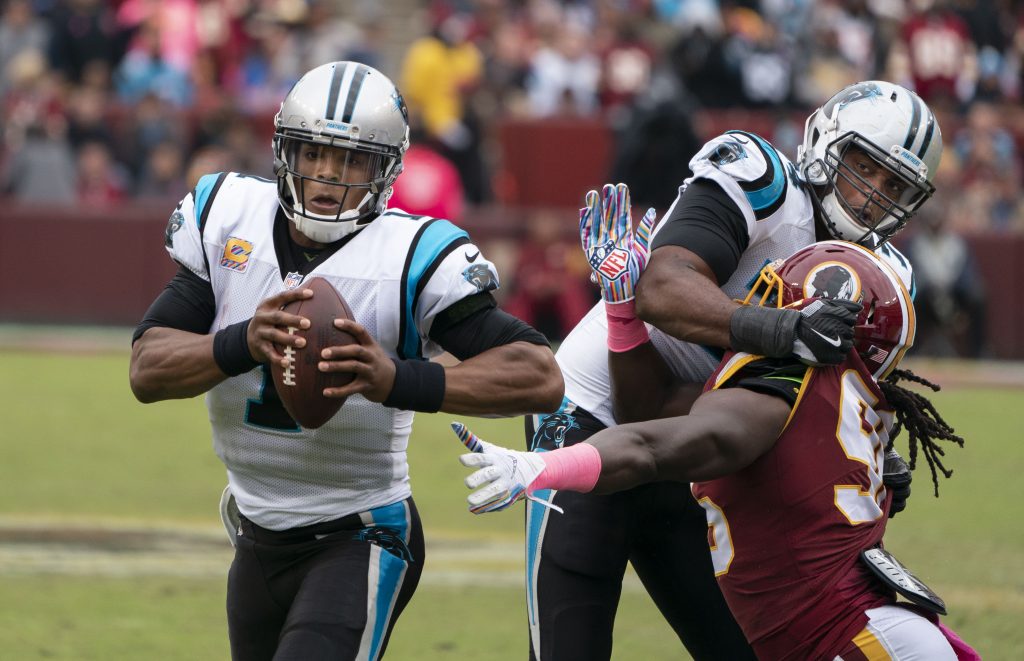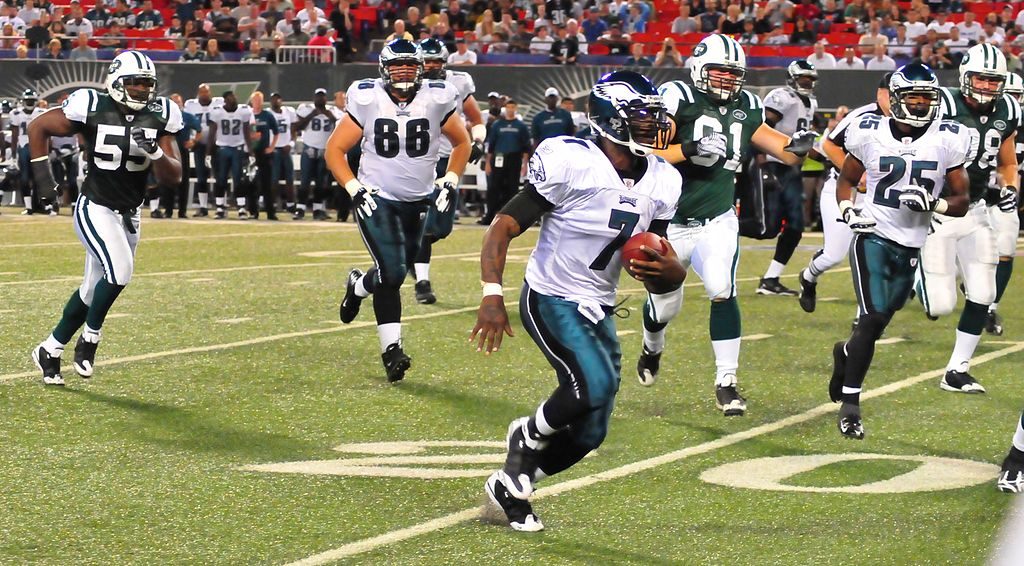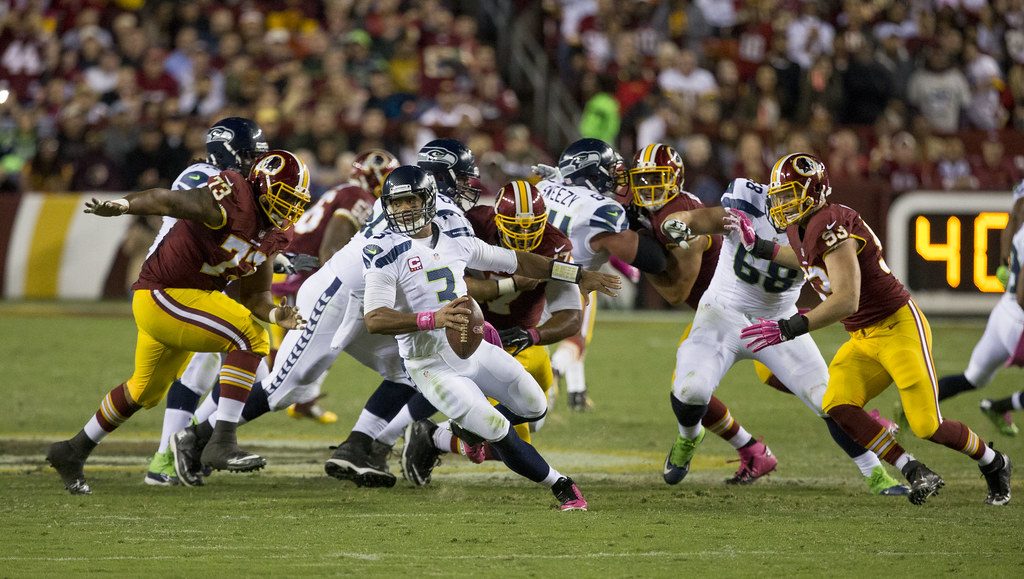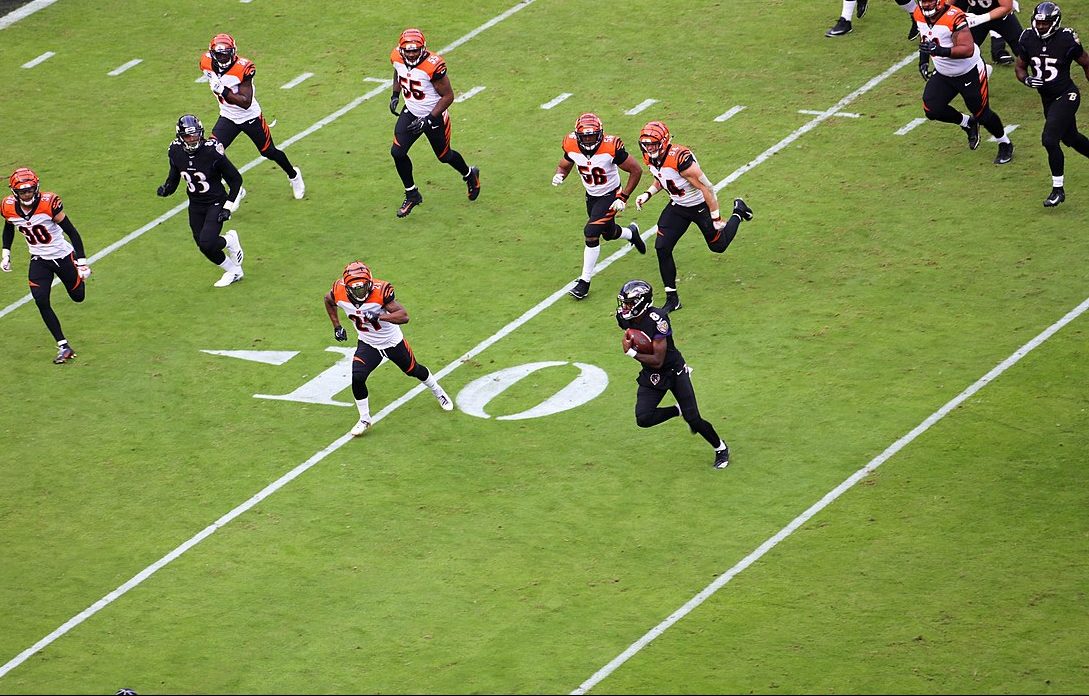Lamar Jackson was the fifth quarterback selected when he was taken 32nd overall in the 2018 NFL Draft. Despite winning the 2016 Heisman Trophy and coming in third in 2017, no team would commit to Jackson as their franchise QB until the Ravens traded for the Eagles’ draft pick and took him with the last pick in the first round. Jackson was an absolute star at Louisville, breaking numerous records and garnering national acclaim. Despite this, few scouts predicted he would be a star quarterback in the pros, at least not to the same level as Baker Mayfield, Sam Darnold, Josh Allen, and Josh Rosen. But outside of Mayfield, Jackson has indisputably been the best of the bunch.
After taking over for Joe Flacco midway through last season, he led Baltimore to a 6-1 record and a playoff berth. This year, Jackson led his squad to wins over the Dolphins and Cardinals with 596 passing yards, 7 passing touchdowns, and 126 rushing yards over two games. He’s been so impressive that some have framed Week 3’s matchup between the Ravens and Patrick Mahomes’ Kansas City Chiefs as a clash of potential MVP candidates.
Can Jackson keep it up?
It’s important to note that his wins this season have come against subpar opponents, so it’s best not to overreact. Additionally, the success of the dual-threat quarterback has been remarkably unstable throughout the history of the NFL, and that is a key reason why Jackson failed to move up on many draft boards. On most lists of all-time great QBs, just a couple of quarterbacks typically make the cut who were capable of getting out of the pocket and speeding past defenders. For every Mike Vick, Cam Newton, or Russell Wilson, there’s been a Vince Young, Tim Tebow, or Johnny Manziel who had promise but quickly faded out of the league.
Yet there’s just something about dual-threat quarterbacks that makes them exciting to watch. While passers like Dan Marino, Peyton Manning, and Tom Brady break down opposing defenses with legendary precision and pinpoint accuracy, speed is simply not a component of their games. Quarterbacks with that extra tool in their pocket can be thought of as more complete players, capable of harming you in a separate, equally dangerous, way.
So, whose footsteps is Jackson following? Which players have done what he is trying to do now, in the past? And who did it best?
Here are the top ten dual-threat quarterbacks of all time:
A note: To qualify as a dual threat quarterback, a player has to have primarily played the QB position and had at least one season eclipsing 500 rushing yards. Sorry, John Elway.
10. Kordell Stewart (1995-2005) PIT, CHI
Career Stats:
14,746 Passing Yards, 77 Passing TDs, 70.7 Passer Rating
2,874 Rushing Yards, 38 Rushing TDs, 5.1 Yards/Attempt
Taking over as the Steelers’ starting QB in 1997, Kordell Stewart oversaw a brief period of mild success in Pittsburgh before the Ben Roethlisberger era. He had a 61% winning percentage over a six-year stretch that culminated with a 13-3 record, a Pro Bowl nod, and the AFC Offensive Player of the Year Award in 2001.
Stewart threw for 3,109 yards in the air that year and developed a solid connection with his favorite target, a young Hines Ward, who had over 1,000 yards receiving. On the ground, Stewart racked up 537 yards, complementing Jerome Bettis as a different type of menace coming out of the Pittsburgh backfield. The Steelers beat the Ravens in the divisional round of the playoffs that season, but fell in the conference championship game to the eventual Super Bowl champion New England Patriots. The next season, Stewart failed to maintain any sort of consistency in his passing game, and was eventually benched. His attempts to revive his career with the Bears did not go well and he was soon out of the league.

Colin Kaepernick was one of the most electrifying dual-threat QBs.
9. Colin Kaepernick (2011-2016) SF
Career Stats:
12,271 Passing Yards, 72 Passing TDs, 88.9 Passer Rating
2,300 Rushing Yards, 13 Rushing TDs, 6.1 Yards/Attempt
With all the media coverage Colin Kaepernick has earned and NFL teams’ reluctance to give him another shot at a starting gig over the past few years, it can be easy to forget that he was, at one point, an extremely effective, bright young quarterback. After taking over for Alex Smith midway through the 2012 campaign, Kaepernick threw for 1,814 yards and ran for 415 over a seven-game span. In that year’s playoffs, he guided the San Francisco 49ers all the way to the notorious blackout Super Bowl, which they lost after mounting a furious second half comeback.
In 2013, his first full season as the Niners’ starter, Kaepernick racked up 3,197 passing yards and 524 rushing yards during the regular season. In the first round of the playoffs, Kaepernick put on an all-time great dual-threat display, notching a quarterback-record 181 yards rushing to go along with 227 yards passing, defeating Aaron Rodgers’ Green Bay Packers in the process. Ultimately, Kaepernick, like so many others, could not solve the Legion of Boom, losing 23-17 to the Seattle Seahawks in the NFC Championship Game, in what was their Super Bowl winning season.
In 2014, Kaepernick had another solid statistical season, including an uptick in rushing yards and yards per attempt, but the Niners had a disappointing 8-8 finish. After that point, his struggles with injuries worsened, and he compiled a 3-16 record as a starter over the next two seasons. He hasn’t played since, but don’t be so sure his career is over; his agent is still contacting teams about starting roles.
8. Daunte Culpepper (1999-2009) MIN, MIA, OAK, DET
Career Stats:
24,153 Passing Yards, 149 Passing TDs, 87.8 Passer Rating
2,652 Rushing Yards, 34 Rushing TDs, 5.2 Yards/Attempt
Daunte Culpepper is best known as Minnesota’s gunslinging QB who tossed the balls that Randy Moss chased down to make some of the most legendary catches in history. But while the two certainly combined to be one of the great QB-WR duos for five seasons, Moss interestingly wasn’t Culpepper’s leading receiver during his best NFL season. In 2004, a down year for Moss, Culpepper relied on second-year pro Nate Burleson, and found enormous success, racking up a league-high 4,717 passing yards and 39 passing touchdowns. Over that five-year span from 2000-2004, Culpepper also proved to be a capable scrambler, rushing for 2,323 yards and 28 touchdowns.
Unfortunately for Vikings fans, the elite level of their offense in the early 2000s was seldom matched by their defense. After making the playoffs all but one year from 1992 to 2000, the team combined for just 28 wins over the next four seasons. Frustrated with mediocrity, Moss departed the team in 2005 and Culpepper left the following season.
Injuries plagued Culpepper for the remainder of his career in Miami, Oakland, and Detroit and he was never able to come close to his production in Minnesota.
7. Steve McNair (1995-2007) HOU, TEN, BAL
Career Stats:
31,304 Passing Yards, 174 Passing TDs, 82.8 Passer Rating
3,590 Rushing Yards, 37 Rushing TDs, 5.4 Yards/Attempt
Steve “Air” McNair has taken on a mythic quality ever since his death from multiple gunshot wounds just a year into retirement. But McNair had every right to be considered an NFL legend long before that tragic day.
Following the retirement of Warren Moon in 1993, the Houston Oilers entered a brief period of decline, accompanied by a nosedive in fan interest following the news that ownership was determined to move the franchise to Nashville, Tennessee. When the team did eventually make that move in 1997, it coincided with McNair’s ascendance to the role of starting quarterback. The first two years in Nashville, he was mediocre through the air, but made up for many shortcomings with his unique athleticism and uncanny ability to escape tackles. Over the 1997 and 1998 seasons, McNair rushed for 1,233 yards and 12 TDs, but the Oilers went just 8-8 both years.
The 1999 season was a different story. With McNair missing five games in the regular season, superstar running back Eddie George carried the bulk of the load for the newly named Titans. The team went 13-3 and made a run to the Super Bowl where they famously fell to ‘The Greatest Show on Turf’ St. Louis Rams, coming up just a yard short of a potential game-tying score on the final play of the game. In 2000, McNair guided Tennessee to another 13-3 campaign, this time remaining healthy the whole year and making his first Pro Bowl appearance (he would make it twice more). Over the next four seasons, the Titans notched 11-plus wins three times, and McNair continued to improve as a passer. In 2003, he had his best season, leading the league in passer rating, and finishing with 24 TDs to just 7 INTs. While his rushing abilities undoubtedly diminished over the course of his career, McNair was always a capable scrambler who moved around the pocket with the best of them.
The Titans made a couple of playoff runs over the course of the McNair era, but never again made it to the Super Bowl. McNair finished his career on the Ravens, guiding an offense powered by Jamal Lewis to a 13-3 record and a first-round exit in the 2006 season.
6. Donovan McNabb (1999-2011) PHI, WAS, MIN
Career Stats:
37,276 Passing Yards, 234 Passing TDs, 85.6 Passer Rating
3,459 Rushing Yards, 29 Rushing TDs, 5.6 Yards/Attempt
Most people don’t think of Donovan McNabb as a runner, but as a young QB, he was a burner and had an array of electric moves to evade defenders. Slippery with the ball in his hands, McNabb used his body well and picked up extra yardage regularly. He ran for over 500 yards on the ground just once, in 2000, but finished as a top ten QB in all time rushing yards.
The second overall pick in the 1999 NFL Draft, McNabb was an elite quarterback by the end of his first year as a starter and contributed to a Philadelphia Eagles team that was among the league’s best in the early 2000s. From 2000-2004, the Eagles won 74% of their games and reached the NFC Championship four times. Their best season during that run, 2004, corresponded with McNabb’s best year under center. That year, McNabb was the NFC’s Pro Bowl starter, throwing for 3,875 yards, 31 TDs, and just eight picks over the course of a 13-3 regular season performance. Accompanied by a prime Terrell Owens and Brian Westbrook, McNabb led the Eagles past Michael Vick’s Falcons in the Divisional Round and Culpepper’s Vikings in the conference championship game, but New England put an end to their run in a tightly contested Super Bowl.
McNabb had three more winning seasons and playoff runs as the Eagles’ starter, but did not return to the Super Bowl, and retired after forgettable seasons with the Redskins and Vikings.

Cam Newton is in a bit of a downswing. Can he reclaim his former dominance in the NFL?
5. Cam Newton (2011-present) CAR
Career Stats:
29,041 Passing Yards, 182 Passing TDs, 86.1 Passer Rating
4,806 Rushing Yards, 58 Rushing TDs, 5.1 Yards/Attempt
It seems strange to say that a player who won the 2015 MVP Award hasn’t lived up to the hype. But perhaps Cam Newton’s best days are still ahead of him. After all, at 30 years old, he has plenty of time to achieve more accolades.
That said, his recent performances are not a strong indication that he’s going to be taking his game to another level any time soon. The Panthers haven’t won a game since their 52-21 smothering Nov. 8 at the hands of Pittsburgh, and Newton has thrown just nine TDs and 10 interceptions over that eight-game span. He hasn’t been compensating on the ground either, with a pedestrian 18 rushing yards per game.
Newton has had one of the league’s better tight ends in Greg Olsen for quite a while, and Christian McCaffrey’s emergence last year as an absolute machine of at running back gave Newton another weapon to work with. However, it just seems like he has rarely had consistent play at wide receiver ever since Steve Smith departed the team in 2014.
After a bright start to Kelvin Benjamin’s career, his play, and his relationship with Newton, both went downhill fast. Ted Ginn and Devin Funchess were effective at times, but both have moved on to other teams. This inconsistency at the receiver position could be a major factor in Newton’s dip from the elite status in recent years. If he is going to move up on this list, it will depend heavily on the rapport he develops with his two young receivers, D.J. Moore and Curtis Samuel.
4. Michael Vick (2001-2015) ATL, PHI, NYJ, PIT
Career Stats:
22,464 Passing Yards, 133 Passing TDs, 80.4 Passer Rating
6,109 Rushing Yards, 36 Rushing TDs, 7.0 Yards/Attempt
Michael Vick is the greatest running quarterback of all time. That goes without question. Among QBs, he has the most total rushing yards by over 1,000 yards and owns the yards per attempt mark (7.0) as well. Vick’s transcendent athleticism made him one of the most recognizable athletes, but his legal issues robbed fans of what could have been an all-time great career.

In his early years, Michael Vick was a cheat code on the ground.
Before Vick spent 21 months in federal prison for his involvement in a dog fighting ring, he was one of the best quarterbacks in the league for the Falcons. A superstar at Virginia Tech, expectations were high for Vick when he came into the league as a first overall pick. His top flight speed, ability to make defenders miss, and a cannon for an arm helped propel the Falcons to playoff appearances in two of his first three years as the starter, and he picked up Pro Bowl nods in 2002, 2004, and 2005.
After his release from prison, Vick signed with the Eagles and had one of the most electrifying seasons in recent memory in 2010. In just 12 games, he compiled 3,018 passing yards and 21 passing TDs to go along with 676 rushing yards and nine rushing TDs. His most memorable performance of the season came against the Redskins on Nov. 15 when he posted six total touchdowns in a 59-28 victory. The Eagles came up short in the Wild Card game that postseason and injuries eventually took their toll on Vick, but he remained an exhilarating runner with one of the strongest arms in NFL history even as he faded from elite status.
3. Randall Cunningham (1985-2001) PHI, MIN, DAL, BAL
Career Stats:
29,979 Passing Yards, 207 Passing TDs, 81.5 Passer Rating
4,928 Rushing Yards, 35 Rushing TDs, 6.4 Yards/Attempt
After head coach Dick Vermeil retired from the Eagles in 1982, Philadelphia endured a losing stretch for much of the decade, but Randall Cunningham eventually came along and resurrected the franchise. In 1988, Cunningham’s first season starting all 16 games, he was named a Pro Bowler and the Eagles went 10-6, making the playoffs.
That was the beginning of a five-year stretch of 10-plus win seasons, during which time Cunningham established himself as one of the league’s top QBs. Cunningham ranks second on the all-time QB rushing yard list, but he was by no means shy about throwing the football. In the 1988 Divisional Round against the Chicago Bears, Cunningham threw 54 times for 407 yards. The same year, he set the franchise record for passing attempts in a game with 62.
At the same time, Cunningham was tearing up it up on the ground, posting the third-most QB rushing yards in a season with 942 on 8.0 yards per attempt in 1990. Unfortunately, he suffered an ACL injury in 1991 that caused him to miss nearly the whole season, and his athleticism never fully recovered.
Still a sharp passer, Cunningham had a late career renaissance with the Vikings, due in no small part to Randy Moss’ emergence in his rookie season. That year, 1992, Cunningham was a First Team All-Pro and led the league in passer rating with 3,704 passing yards, 34 passing TDs, and just 10 interceptions. Minnesota went 15-1, and seemed destined for the Super Bowl, but lost a heartbreaking NFC Championship Game to the Falcons in overtime. Cunningham’s play took a step back in 1999, and he wouldn’t be a full-time starter for the remainder of his career.

Russell Wilson is as good a mix of run and pass that you’ll see in the league today.
2. Russell Wilson (2012-present) SEA
Career Stats:
26,111 Passing Yards, 201 Passing TDs, 100.9 Passer Rating
3,681 Rushing Yards, 16 Rushing TDs, 5.6 Yards/Attempt
Russell Wilson’s high spot on this list might raise some eyebrows, but he has been one of the league’s elite quarterbacks for quite some time now, and his Super Bowl ring and five Pro Bowl appearances bolster his resume. If that were not enough, his 100.9 career passer rating puts him at second all-time, trailing only Aaron Rodgers.
Like Jackson, Wilson had a slew of quarterbacks selected before him. For Jackson, scouts distrusted his accuracy. For Wilson, it was his height. But Wilson’s doubters are nowhere to be seen now. The 5’11’’ Wisconsin product has posted 3000 yards and 20 passing TDs every year of his career, and the Seahawks have had winning seasons every year he’s been under center. With his now elite passing ability, Wilson’s running talents come as an afterthought, but he has eclipsed 500 rushing yards four times, including 849 yards on 7.2 yards per attempt in 2014.
Wilson will forever be associated with the Legion of Boom years and Seattle’s trips to the Super Bowl in the 2013 and 2014 seasons. But the Seahawks’ impenetrable defense fell apart almost as quickly as it emerged. Richard Sherman, Earl Thomas, and Kam Chancellor have all departed the team in recent seasons, and the current Seattle roster now has an entirely different character than the dominant ones from those championship runs. And yet the Seahawks continue to be one of the league’s best teams year after year. It has been up to Wilson to maintain the winning culture, and he has been up to the task. In 2015 and 2017, Wilson notched 500-plus rushing yards and was among the league leaders in passing yards and TDs, garnering MVP consideration both years. If Wilson keeps the Seahawks winning in the post-Marshawn Lynch and Legion of Boom era, he could very well climb to the top of this list when it’s all said and done.
1. Steve Young (1985-1999) TB, SF
Career Stats:
33,124 Passing Yards, 232 Passing TDs, 96.8 Passer Rating
4,239 Rushing Yards, 43 Rushing TDs, 5.9 Yards/Attempt
Steve Young is a Hall of Famer, a two-time MVP, and seven-time Pro Bowler. Taking the reins from Joe Montana full time in 1991, Young immediately emerged as a prodigious talent, leading the league in passer rating (which he would do five more times). In 1992, Young had his first of three-straight First Team All-Pro performances.
A confident and oftentimes reckless runner, he also racked up 537 rushing yards that year. While Young did not have the huge rushing seasons like some of the other quarterbacks on this list, he was able to endure as a mobile passer in the league longer than anyone else on this list. His 43 rushing touchdowns rank second most all-time among quarterbacks.
Young’s 1994 season was what placed him among the ranks of legendary QBs. He threw for 3,969 yards and a then-franchise record 35 passing TDs, completing 70.3% of his passes, the third best season mark all time. He also demonstrated his incredible scrambling ability throughout the year, and finished with seven rushing TDs. His efforts were enough to win his second MVP and secured the Niners a 13-3 record. In the playoffs, he was even better. Young posted a 117.4 passer rating and nine passing TDs over three games in the postseason, and San Francisco took down the San Diego Chargers 49-26 in the Super Bowl.
Despite not returning to the Super Bowl, Young made the Pro Bowl each of the next four seasons, including 1998, when he had 4,170 passing yards and 36 passing TDs as a 37-year-old. While not the best rushing quarterback on this list, Young was easily the greatest all-around and he has plenty of accolades to back that up.
(All stats courtesy of pro-football-reference.com)






